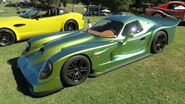The Patriot Trident GTR is a fanonical Supercar created by JustAlex93.
Details[]

Trident GTR racer, FROG Racing livery
Developed in the mid-1990s for the 1997 GT Championship, the Trident GTR is a GT1 class racing car. Though named after the Trident roadster, it had no mechanical relationship to the production car, instead only sharing minor styling points.
The higher-ups of Patriot, wanting to keep an American-style design, insisted for the car to be based on the Trident roadster in one way or another. As a result, the Trident GTR became unique in comparison to European counterparts in that, like the Trident roadster, the engine is located in front of the cockpit. However, the engine is placed midship in the car behind the front axle, giving it unusual proportions, including a large nose with a bulging intake and the cockpit being placed as far back in the body. Following the 1997 season, the bodywork was modified by lengthening the front and rear areas for increased downforce and handling capabilities.
For the engine, Patriot attempted to keep the American theming of the Trident GTR by implementing a V8 engine similar to the one from the Trident roadster. Instead of the standard 4.8L V8, a racing-grade 6.0L V8 based on the Trident roadster's engine was used.
At one point, Patriot decided to experiment with hybrid electric engine technology in the Trident GTR. For this, the Trident GTR R9 Hybrid was developed with such an engine for the 1998 season. It was also given a unique purple livery with large yellow lightning bolts. The idea was that the car would get better fuel mileage by using an electric motor that would help drive the rear wheels during acceleration, thus needing less power from the gasoline engine and burning up less fuel. Of course, the electric motor would need batteries. To recharge them, a regenerative braking system would be implemented, with the same electric motor now being used to generate electricity. This would reduce the wastage of energy normally emitted as heat from the brakes. By using less fuel, the car would thus be able to make fewer pit stops in endurance races, such as the 24 Hours of Le Mans, and therefore could spend more time on the track and go farther. Unfortunately, though it did gain a class win at the Petit Le Mans, the hybrid electric engine system proved unreliable, as at the time, lighter and better battery technologies weren't yet available in 1998.
To meet homologation requirements, Patriot would produce three road-legal Trident GTRs, which had a smaller 5.8L V8. One of these would be retained by the company, the other two being in the hands of private collectors.
At the end of 1998, the GT1 category was discontinued by the FIA GT Championship and the U.S. Road Racing Championship, leaving the Trident GTR with nowhere to go racing. This lead to the development of the Trident LMP for the Le Mans Prototype category.
In regards to the road-legal model of the GTR, rumors came about that Patriot considered on resuming production of the car, this time as a made-to-order vehicle. When it was confirmed by official sources, Mash made the decision to order several Trident GTRs for use in the Festival, a combination of both the road-legal and racing versions with at least one R9 Hybrid among them. Of course, the mechanics aboard the Carrier would make modifications to the R9 Hybrid's system to increase reliability.
Trivia[]
- The Trident GTR and Trident roadster were inspired by the Panoz GTR-1 and Esperante, respectively.
- Except, however, the Trident GTR uses headlights like those of the TVR Tuscan S, in addition to the tail lights of the Nissan R33 Skyline GT-R.










